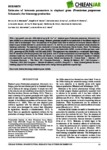Please use this identifier to cite or link to this item:
http://www.alice.cnptia.embrapa.br/alice/handle/doc/1036011| Title: | Estimates of heterosis parameters in elephant grass (Pennisetum purpureum Schumach.) for bioenergy production. |
| Authors: | MENEZES, B. R. S.  DAHER, R. F.   GRAVINA, G. de A.   PEREIRA, A. V.   SOUSA, L. B.   RODRIGUES, E. V.   SILVA, V. B.   GOTTARDO, R. D.   SCHNEIDER, L. S. A.   NOVO, A. A. C.   |
| Affiliation: | Bruna R.S. Menezes, Universidade Estadual do Norte Fluminense; Rogerio F. Daher, Universidade Estadual do Norte Fluminense; Geraldo de A. Gravina, Universidade Estadual do Norte Fluminense; ANTONIO VANDER PEREIRA, CNPGL; Liliane B. Sousa, Universidade Estadual do Norte Fluminense; Erina V. Rodrigues, Universidade Estadual do Norte Fluminense; Veronica B. Silva, Universidade Estadual do Norte Fluminense; Romildo D. Gottardo, Universidade Estadual do Norte Fluminense; Larissa S.A. Schneider, Universidade Estadual do Norte Fluminense; Antonio A.C. Novo, Instituto Federal Fluminense. |
| Date Issued: | 2015 |
| Citation: | Chilean Journal of Agricultural Research, v.75, n.4, p. 395-401, 2015. |
| Description: | With a high growth rate and a DM yield of up to 80 t ha-1 yr-1, elephant grass (Pennisetum purpureum Schumach.) has been utilized as an alternative source of energy. However, genotypes adapted to and productive in the different regions of Brazil need to be developed. Thus, the objectives of the present study were to estimate and evaluate heterotic effects in elephant-grass hybrids obtained in a partial diallel cross (5 × 5), with the aim of assisting the superior hybrids selection for bioenergy production. The experiment was conducted in Campos dos Goytacazes, Rio de Janeiro, Brazil. The following traits were evaluated: plant height (HGT), stem diameter (SD), leaf blade width (LBW), number of tillers per linear meter (NT), percentage of DM (%DM), and DM yield (DMY). The experiment was conducted in a randomized block design, with 35 treatments (five female parents, five male parents, and 25 hybrid combinations) and three replicates. The adopted statistical model was that of Miranda Filho and Geraldi, in an adaptation of Gardner and Eberhart. Significant heterosis was observed for most traits in the rainy and dry seasons. Hybrid combinations H1 (?Cubano Pinda? × ?Mercker?), H7 (?Cameroon-Piracicaba? × ?Três Rios?), H8 (?Cameroon-Piracicaba? × ?Mercker 86-México?), H17 (?IAC-Campinas? × ?Três Rios?), H18 (?IAC-Campinas? × ?Mercker 86-México?), and H25 (?Guaçu/IZ.2? × ?Roxo?) showed potential for use in breeding programs that aiming at develop clones with a energy biomass production capacity high. |
| NAL Thesaurus: | hybrids |
| Keywords: | Alternative energy Elephant grass |
| Type of Material: | Artigo de periódico |
| Access: | openAccess |
| Appears in Collections: | Artigo em periódico indexado (CNPGL)  |
Files in This Item:
| File | Description | Size | Format | |
|---|---|---|---|---|
| Cnpgl2015ChileanJAREstimates.pdf | 207,65 kB | Adobe PDF |  View/Open |









